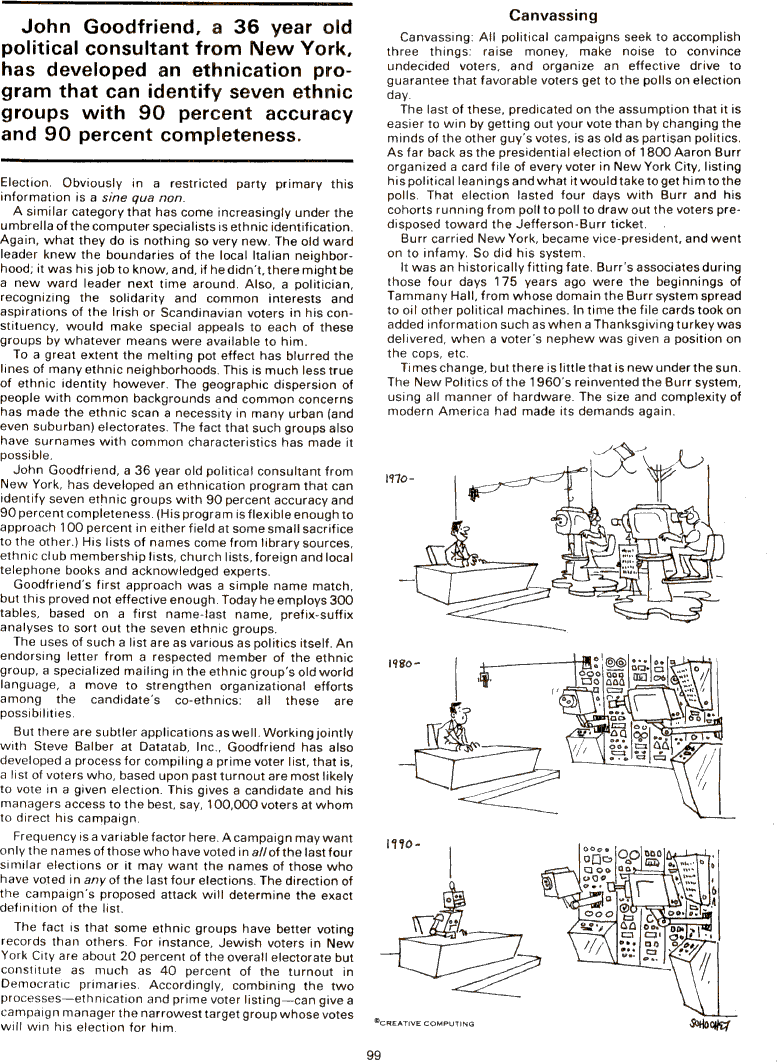The Best of Creative Computing Volume 2 (published 1977)
Polls, Pols, and Power: The Computer on the Hustings (canvassing)

John Goodfriend, a 36 year old political consultant from New York, has developed
an ethnication program that can identify seven ethnic groups with 90 percent
accuracy and 90 percent completeness.
Election. Obviuosly in a restricted party primary this information is a sine qua
non.
A simililar category that has come increasingly under the umbrella of the
computer specialists is ethnic identification. Again, what they do is nothing so
very new. The old ward leader knew the boundaries of the local Italian
neighborhood; it was his job to know, and, if he didn't, there might be a new
ward leader next time around. Also, a politician, recognizing the solidarity and
common interests and aspirations of the Irish or Scandinavian voters in his
voters in his constituency, would make special appeals to each of these groups
by whatever means were available to him.
To a great extent the melting pot effect has blurrd the lines of many ethnic
neighborhoods. This is much less true of ethnic identity however. The geographic
dispersion of people with common backgrounds and common concerns has made the
ethnic scan a necessity in many urban (and even subarban) electorates. The fact
that such groups also have surnames with common characteristics has made it
possible.
John Goodfriend, a 36 year old political consultant from New York, has developed
an ethnication program that can identify seven ethnic groups with90 percent
accuracy and 90 percent completeness. (His program is flexible enough to
approach 100 percent in either field at some small sacrifice to the other.) His
lists of names come from library sources, ethnic club membership lists, church
lists, foreign and local telephone books and acknowledged experts.
Goodfriend's first approach was a simple name match, but this proved not
effective enough. Today he employs 300 tables based on a first name-last name,
prefix-suffix analyses to sort out the seven ethnic groups.
The uses of such a list are as various as politics itself. An endorsing letter
from a respected member of the ethnic group, a specialized mailing in the ethnic
group's old world language, a move to strengthen organizational efforts among
the candidate's co-ethnics: all these are possibilities.
But there are subtler applications as well. Working jointly with Steve Nalber at
Datatab Inc., Goodfriend has also developed a process for compiling a prime
voter list, that is, a list of voters who, based upon past turnout are most
likely to vote in a given election. This gives a candidate and his managers
access to the best, say, 100,000 voters at whom to direct his campaign.
Frequency is a variable factor here. A campaign may want only the names of those
who have voted in all of the last four similar elections or it may want the
names of those who have voted in all of the last four elections. The direction
of the campaign's proposed attack will determine the exact definition of the
list.
The fact is that some ethnic groups have better voting records than others. For
instance, Jewish voters in New York City are about 20 percent of the overall
electorate but constitute as much as 40 percent of the turnout in Democratic
primaries. Accordingly, combining the two processes-ethnication and prime voter
listing-can give a campaign manager the narrowest target group whose votes will
win his election for him
Canvassing
Canvassing: All political campaigns seek to accomplish three things: raise
money, make noise to convince undecided voters, and organize an effective drive
to guarantee that favorable voters get to the polls on election day.
The last of these, predicated on the assumption that it is easier to win by
getting out your vote than by changing the minds of the other guy's votes, is as
old as partisan politics. As far back as the presidential election of 1800 Aaron
Burr organized a card file of every voter in New York City, listing his
political leanings and what it would take to get him to the polls. That election
lasted four days with Burr and his cohorts running from poll to poll to draw out
the voters predisposed toward the Jefferson-Burr ticket.
Burr carried New York, became vice-president, and went on to infamy. So did his
system. It was an historically fitting fate. Burr's associates during those four
days 175 years ago were the beginnings of Tammany Hall, from whose domain the
Burr system spread to oil other political machines. In time the file cards took
on added information such as when a Thanksgiving turkey was delivered, when a
voter's nephew was given a position on the cops, etc.
Times change, but there is little that is new under the sun. The New Politics of
the 1960's reinvented the Burr system, using all manner of hardware. The size
and complexity of modern America had made its demands again.


